Business Intelligence - Big Data and Performance
Added on 2022-03-05
39 Pages7601 Words154 Views
ESOFT (BUSINESS INTELLIGENCE)
1
Contents
Introduction...........................................................................................................................................................................2
Task 1: ...................................................................................................................................................................................3
1.1) Analyse the business processes and the supporting processes of the organization given in the scenario and
differentiate between semi structured and unstructured data. Evaluate the benefits and drawbacks of using application
software to handle the business processes in Yard of Ale.................................................................................................3
What is Yard of Ale Business Process?.............................................................................................................................4
What is Supporting Process? .........................................................................................................................................5
Explain data that have been used by the different process models given above.........................................................6
Difference between Structured, Semi-structured and Unstructured data ...................................................................7
What are the application software used in the given process Models. ........................................................................9
Evaluate the benefits and drawbacks of using application software to handle the business processes in Yard of Ale. ..9
Sisense .........................................................................................................................................................................10
Looker..........................................................................................................................................................................10
Reporting .....................................................................................................................................................................11
Data Mining.................................................................................................................................................................11
Compare how strategic, tactical and operational decisions are supported within the organization for business
decision making process. You have to furthermore compare and contrast how various information systems
(TPS,MIS,DSS) could be utilized to enhance those decisions with related to key features of BI framework . Justify your
answer with relevant to the functionalities of business intelligence..............................................................................12
Hierarchical structure ..................................................................................................................................................12
Line Organizational Structure......................................................................................................................................15
Sisense .........................................................................................................................................................................16
Executive Dashboards .................................................................................................................................................16
Task 3 ..................................................................................................................................................................................20
3.1. Explain what business intelligence is and the tools and technologies associated with it by taking relevant examples
to the organization given in the scenario. ........................................................................................................................20
Task 4 ..................................................................................................................................................................................27
4.1. Discuss how organizational decision-making process can be improved by implementing business intelligence
tools. Conduct research to identify the organizations that have utilized new business intelligent innovations and trends
to improve their performance and to extend BI systems to target audience, provide better competitive advantage within
the market. .......................................................................................................................................................................27
4.2. Sharing data within the organization through a BI tool can raise legal, ethical and professional concerns. Explore
the legal issues that may result when using business intelligence tools (Eg: Data protection laws, Cyber security, etc.)
31
Conclusion ...........................................................................................................................................................................38
References ..........................................................................................................................................................................39
1
Contents
Introduction...........................................................................................................................................................................2
Task 1: ...................................................................................................................................................................................3
1.1) Analyse the business processes and the supporting processes of the organization given in the scenario and
differentiate between semi structured and unstructured data. Evaluate the benefits and drawbacks of using application
software to handle the business processes in Yard of Ale.................................................................................................3
What is Yard of Ale Business Process?.............................................................................................................................4
What is Supporting Process? .........................................................................................................................................5
Explain data that have been used by the different process models given above.........................................................6
Difference between Structured, Semi-structured and Unstructured data ...................................................................7
What are the application software used in the given process Models. ........................................................................9
Evaluate the benefits and drawbacks of using application software to handle the business processes in Yard of Ale. ..9
Sisense .........................................................................................................................................................................10
Looker..........................................................................................................................................................................10
Reporting .....................................................................................................................................................................11
Data Mining.................................................................................................................................................................11
Compare how strategic, tactical and operational decisions are supported within the organization for business
decision making process. You have to furthermore compare and contrast how various information systems
(TPS,MIS,DSS) could be utilized to enhance those decisions with related to key features of BI framework . Justify your
answer with relevant to the functionalities of business intelligence..............................................................................12
Hierarchical structure ..................................................................................................................................................12
Line Organizational Structure......................................................................................................................................15
Sisense .........................................................................................................................................................................16
Executive Dashboards .................................................................................................................................................16
Task 3 ..................................................................................................................................................................................20
3.1. Explain what business intelligence is and the tools and technologies associated with it by taking relevant examples
to the organization given in the scenario. ........................................................................................................................20
Task 4 ..................................................................................................................................................................................27
4.1. Discuss how organizational decision-making process can be improved by implementing business intelligence
tools. Conduct research to identify the organizations that have utilized new business intelligent innovations and trends
to improve their performance and to extend BI systems to target audience, provide better competitive advantage within
the market. .......................................................................................................................................................................27
4.2. Sharing data within the organization through a BI tool can raise legal, ethical and professional concerns. Explore
the legal issues that may result when using business intelligence tools (Eg: Data protection laws, Cyber security, etc.)
31
Conclusion ...........................................................................................................................................................................38
References ..........................................................................................................................................................................39
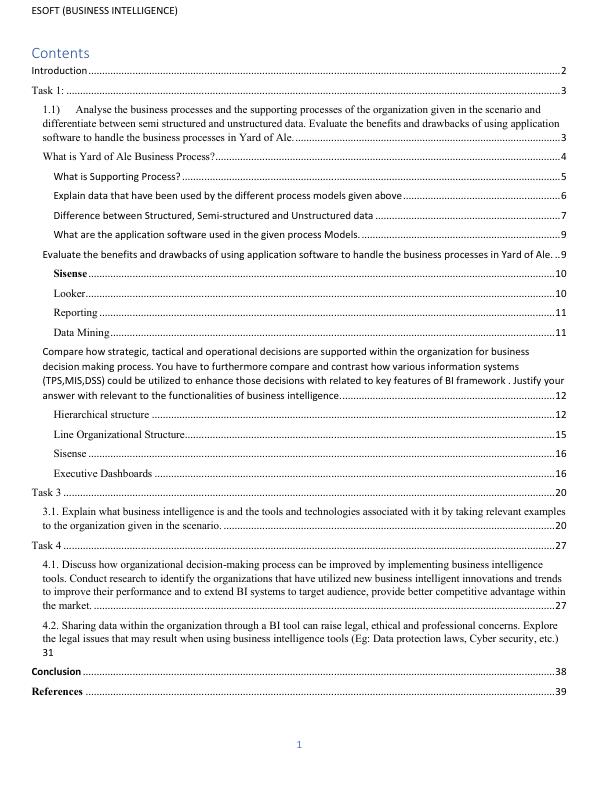
ESOFT (BUSINESS INTELLIGENCE)
2
Introduction
Business intelligence (BI) is all about turning an organization’s data into insights that can be used to inform
business decisions. BI analysts will use BI tools, software or services to access and analyze datasets and translate
their findings into reports, summaries, dashboards, graphs, charts or maps.
In recent years, the advent of modern data visualization and reporting tools has transformed the discipline,
empowering businesses to use big data insights to identify, develop and create new business opportunities.
Howard Dresner played a key role in popularizing business intelligence during his time as a VP and Research
Fellow at Gartner. In 1989, he defined business intelligence as an umbrella term which describes concepts and
methods that can help businesses use “fact-based support systems” to improve their decision-making.
Today, Forrester defines business intelligence as “a set of methodologies, processes, architectures and
technologies that transform raw data into meaningful and useful information”. This can then be “used to enable
more effective strategic, tactical and operational insights and decision-making”.
Some would argue that data management and ingestion should not be the business intelligence team’s
responsibility. But it is widely acknowledged that BI professionals currently spend a significant amount of their
time on data preparation and cleaning data.
BI should not be confused with ‘business analytics’. Business intelligence is descriptive and uses metrics to
generate clear snapshots of business performance. Meanwhile, business analytics is predictive, and describes
what organizations should do in future to generate better outcomes..
2
Introduction
Business intelligence (BI) is all about turning an organization’s data into insights that can be used to inform
business decisions. BI analysts will use BI tools, software or services to access and analyze datasets and translate
their findings into reports, summaries, dashboards, graphs, charts or maps.
In recent years, the advent of modern data visualization and reporting tools has transformed the discipline,
empowering businesses to use big data insights to identify, develop and create new business opportunities.
Howard Dresner played a key role in popularizing business intelligence during his time as a VP and Research
Fellow at Gartner. In 1989, he defined business intelligence as an umbrella term which describes concepts and
methods that can help businesses use “fact-based support systems” to improve their decision-making.
Today, Forrester defines business intelligence as “a set of methodologies, processes, architectures and
technologies that transform raw data into meaningful and useful information”. This can then be “used to enable
more effective strategic, tactical and operational insights and decision-making”.
Some would argue that data management and ingestion should not be the business intelligence team’s
responsibility. But it is widely acknowledged that BI professionals currently spend a significant amount of their
time on data preparation and cleaning data.
BI should not be confused with ‘business analytics’. Business intelligence is descriptive and uses metrics to
generate clear snapshots of business performance. Meanwhile, business analytics is predictive, and describes
what organizations should do in future to generate better outcomes..
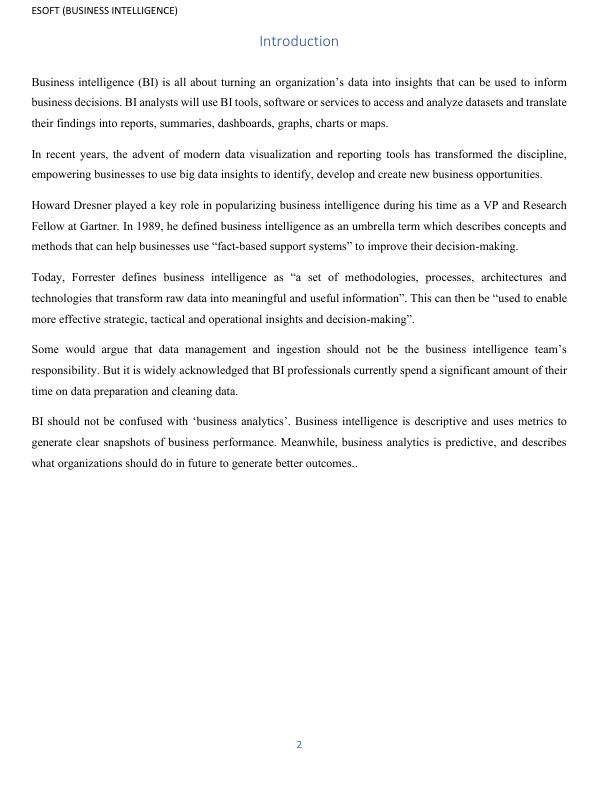
ESOFT (BUSINESS INTELLIGENCE)
3
Task 1:
Name of Company: Yard of Ale brewery company (PVT) Ltd.
1.1) Analyse the business processes and the supporting processes of the organization given in the scenario
and differentiate between semi structured and unstructured data. Evaluate the benefits and drawbacks of using
application software to handle the business processes in Yard of Ale.
MANAGING DIRECTOR – Secretary
Director - Secretary
General Manager
Manager
Sales and Marketing Finance Division Administration
Quality control Accountant
Production Senior Supervisor IT
Research and development
Marketing Manager HR/Legal
Secretary
Marketing Accounts Clerks
Assistant Investigators
Supervisor
Senior Co-ordinator
Co-ordinator
Assistant Co-ordinator
Recovery Officer
Supervisor
Senior Co-ordinator
Co-ordinator
Assistant Co-ordinator
Recovery Officer
3
Task 1:
Name of Company: Yard of Ale brewery company (PVT) Ltd.
1.1) Analyse the business processes and the supporting processes of the organization given in the scenario
and differentiate between semi structured and unstructured data. Evaluate the benefits and drawbacks of using
application software to handle the business processes in Yard of Ale.
MANAGING DIRECTOR – Secretary
Director - Secretary
General Manager
Manager
Sales and Marketing Finance Division Administration
Quality control Accountant
Production Senior Supervisor IT
Research and development
Marketing Manager HR/Legal
Secretary
Marketing Accounts Clerks
Assistant Investigators
Supervisor
Senior Co-ordinator
Co-ordinator
Assistant Co-ordinator
Recovery Officer
Supervisor
Senior Co-ordinator
Co-ordinator
Assistant Co-ordinator
Recovery Officer

ESOFT (BUSINESS INTELLIGENCE)
4
Introduction
This report focuses on the outcome that collected through the research process on business intelligences. The
report discusses about business processes and decision support processes in overall, as well as, evaluate the use
of organizational applications and data for these processes. In addition, the report also shown the result related
to the main structures of business intelligence and attached with comparing the types of support for decision-
making at dissimilar levels (operational, tactical and strategic), as well as the technology or system that make
that possible. The report divided into two main point, includes:
• Discuss business processes and the mechanism used to support business decision-making
• Compare the tools and technologies associated with business intelligence functional
Analyze, using examples, the terms ‘Business Process’ and ‘Supporting Processes’
What is Yard of Ale Business Process?
Yard of Ale brewery company (PVT) Ltd is a business process outsourcing (BPO) Company which provide
services and goods during the customer lifecycle, Recoveries, Investigations, customer acquisition, customer
care, and transactions
Yard of Ale has a team of professionals with experience in business process outsourcing Services. Our client-
oriented business workers and support staff have been carefully selected for experience, proper attitudes and
values, and are thoroughly trained and supervised to ensure that they are regularly maintaining your good public
image.
The concept of our executive management team and the infrastructure of our professionals enable us to work
with only the best integrity. As well our team of full-time employees, we also have empaneled freelance & part-
time professionals with particular skills who are available on call, Depending on the needs of your project. We
also understand that having the latest technologies is not enough, we have consequently, built a management
team that has both knowledge and leadership qualities that command the highest level of expectations.
Anyone who is part of Yard of Ale BPO Services is geared to assure quality, co-ordinate with customers and
research & develop new systems & solutions. While we are focused on setting up and managing a high-quality
operation, we are also intensely focused on being an ‘intelligent’ business processes outsourcing partner.
Our status for putting the customer first in every area of our operation is the most important contributor to our
success and to the success of the customers we serve.
4
Introduction
This report focuses on the outcome that collected through the research process on business intelligences. The
report discusses about business processes and decision support processes in overall, as well as, evaluate the use
of organizational applications and data for these processes. In addition, the report also shown the result related
to the main structures of business intelligence and attached with comparing the types of support for decision-
making at dissimilar levels (operational, tactical and strategic), as well as the technology or system that make
that possible. The report divided into two main point, includes:
• Discuss business processes and the mechanism used to support business decision-making
• Compare the tools and technologies associated with business intelligence functional
Analyze, using examples, the terms ‘Business Process’ and ‘Supporting Processes’
What is Yard of Ale Business Process?
Yard of Ale brewery company (PVT) Ltd is a business process outsourcing (BPO) Company which provide
services and goods during the customer lifecycle, Recoveries, Investigations, customer acquisition, customer
care, and transactions
Yard of Ale has a team of professionals with experience in business process outsourcing Services. Our client-
oriented business workers and support staff have been carefully selected for experience, proper attitudes and
values, and are thoroughly trained and supervised to ensure that they are regularly maintaining your good public
image.
The concept of our executive management team and the infrastructure of our professionals enable us to work
with only the best integrity. As well our team of full-time employees, we also have empaneled freelance & part-
time professionals with particular skills who are available on call, Depending on the needs of your project. We
also understand that having the latest technologies is not enough, we have consequently, built a management
team that has both knowledge and leadership qualities that command the highest level of expectations.
Anyone who is part of Yard of Ale BPO Services is geared to assure quality, co-ordinate with customers and
research & develop new systems & solutions. While we are focused on setting up and managing a high-quality
operation, we are also intensely focused on being an ‘intelligent’ business processes outsourcing partner.
Our status for putting the customer first in every area of our operation is the most important contributor to our
success and to the success of the customers we serve.

ESOFT (BUSINESS INTELLIGENCE)
5
What is Supporting Process?
Recovery Company
If after many attempts to collect on overdue accounts, you are still losing at the debt recovery payment, it may
be time to enlist the help of a recovery Company. They can take on the difficult challenge of tracking down your
debtors. Once contact has been made, the recovery Company will attempt to secure payment-in-full on your
behalf. If the debtor cannot pay the full amount, a payment plan may be put into place. Of course, the final
decision is always authorized by you, the creditor.
Financial Consideration
Yard and Ale follows a Fair Debt Collection Practice. The Company will take a percentage of the debt which
successfully collected; sometimes known in the industry as the "Pot Fee" or potential fee upon successful
collection. This does not necessarily have to be upon collection of the full balance. The Company makes money
only if money is collected from the debtor (often known as a "No Collection - No Fee" basis), Depending on the
type of debt, the age of the account and how many attempts have already been made to collect on.
Call a Center
Collection calls inform debtors of their obligations and motivate repayment. If a person answers, the call center
may track statistics (e.g., the times and days when someone answers), in order to place calls at times when the
debtor is more likely to be home. We also prohibit from using deceptive practices (for example, obscene language
or threatening the debtor with arrest, impersonating law enforcement, or tricking the debtor into making a
payment).
Successful collection calls also rely on the skill and understanding of the collector making the call. From first
initial phone call, we try to establish a rapport with the debtor and to help work out a solution to the debt owed.
This may take the form of a payment plan or a discount on the principal amount that is owed.
5
What is Supporting Process?
Recovery Company
If after many attempts to collect on overdue accounts, you are still losing at the debt recovery payment, it may
be time to enlist the help of a recovery Company. They can take on the difficult challenge of tracking down your
debtors. Once contact has been made, the recovery Company will attempt to secure payment-in-full on your
behalf. If the debtor cannot pay the full amount, a payment plan may be put into place. Of course, the final
decision is always authorized by you, the creditor.
Financial Consideration
Yard and Ale follows a Fair Debt Collection Practice. The Company will take a percentage of the debt which
successfully collected; sometimes known in the industry as the "Pot Fee" or potential fee upon successful
collection. This does not necessarily have to be upon collection of the full balance. The Company makes money
only if money is collected from the debtor (often known as a "No Collection - No Fee" basis), Depending on the
type of debt, the age of the account and how many attempts have already been made to collect on.
Call a Center
Collection calls inform debtors of their obligations and motivate repayment. If a person answers, the call center
may track statistics (e.g., the times and days when someone answers), in order to place calls at times when the
debtor is more likely to be home. We also prohibit from using deceptive practices (for example, obscene language
or threatening the debtor with arrest, impersonating law enforcement, or tricking the debtor into making a
payment).
Successful collection calls also rely on the skill and understanding of the collector making the call. From first
initial phone call, we try to establish a rapport with the debtor and to help work out a solution to the debt owed.
This may take the form of a payment plan or a discount on the principal amount that is owed.

ESOFT (BUSINESS INTELLIGENCE)
6
Explain data that have been used by the different process models given above
Understanding the collection process
Understanding the collection process is the key to working with a Recovery Company.
We will provide you with all the necessary information to assist you in your account receivable management,
also to make an informed decision and act as an extension of your office.
To Implement Recovery Process
(1) Have to sign an Agreement with You & Yard and Ale BPO (Pvt) Ltd.
(2) For Recoveries Pl provide
• Customer Information Sheet, (Loans, Credit Cards.)
For Investigations Pl Provide
• Information Type 1 (People Outside the Company)
• Information Type 2 (People within the Company)
(3) Please Issue Us Temporary Receipt Book(s)
(4) Identity Card / Authorization Letter
6
Explain data that have been used by the different process models given above
Understanding the collection process
Understanding the collection process is the key to working with a Recovery Company.
We will provide you with all the necessary information to assist you in your account receivable management,
also to make an informed decision and act as an extension of your office.
To Implement Recovery Process
(1) Have to sign an Agreement with You & Yard and Ale BPO (Pvt) Ltd.
(2) For Recoveries Pl provide
• Customer Information Sheet, (Loans, Credit Cards.)
For Investigations Pl Provide
• Information Type 1 (People Outside the Company)
• Information Type 2 (People within the Company)
(3) Please Issue Us Temporary Receipt Book(s)
(4) Identity Card / Authorization Letter
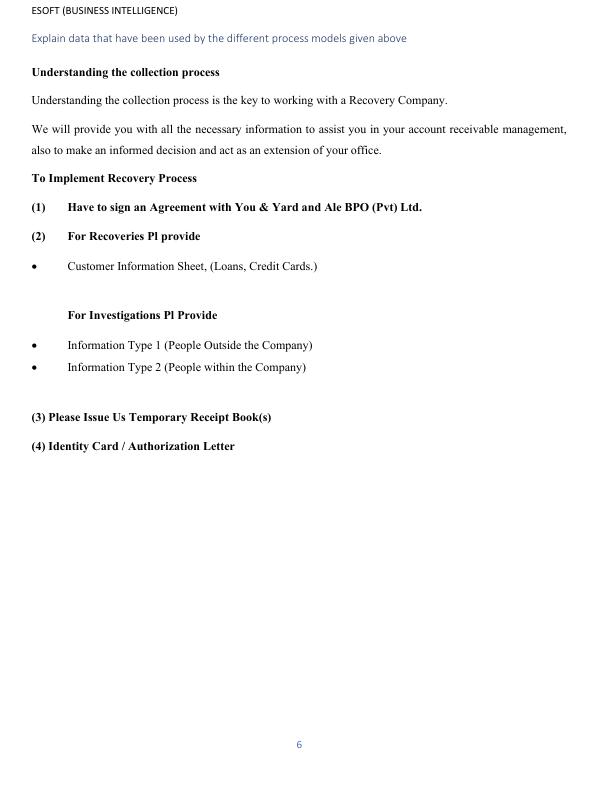
ESOFT (BUSINESS INTELLIGENCE)
7
Difference between Structured, Semi-structured and Unstructured data
Big Data contains vast volume, high velocity, and extensible variety of data. These are 3 types: Structured data,
Semi-structured data, and Unstructured data.
Structured data
Structured data is data whose elements are addressable for effective analysis. It has been organized into a
formatted repository that is typically a database. It concerns all data which can be stored in database SQL in a
table with rows and columns. They have relational keys and can easily be mapped into pre-designed fields.
Today, those data are most processed in the development and simplest way to manage information. Example:
Relational data.
Semi-Structured data
Semi-structured data is information that does not reside in a relational database but that has some organizational
properties that make it easier to analyze. With some processes, you can store them in the relation database (it
could be very hard for some kind of semi-structured data), but Semi-structured exist to ease space. Example:
XML data.
Unstructured data
Unstructured data is a data which is not organized in a predefined manner or does not have a predefined data
model, thus it is not a good fit for a mainstream relational database. So for Unstructured data, there are alternative
platforms for storing and managing, it is increasingly prevalent in IT systems and is used by organizations in a
variety of business intelligence and analytics applications. Example: Word, PDF, Text, Media logs.
differences between Structured, Semi-structured and Unstructured data:
7
Difference between Structured, Semi-structured and Unstructured data
Big Data contains vast volume, high velocity, and extensible variety of data. These are 3 types: Structured data,
Semi-structured data, and Unstructured data.
Structured data
Structured data is data whose elements are addressable for effective analysis. It has been organized into a
formatted repository that is typically a database. It concerns all data which can be stored in database SQL in a
table with rows and columns. They have relational keys and can easily be mapped into pre-designed fields.
Today, those data are most processed in the development and simplest way to manage information. Example:
Relational data.
Semi-Structured data
Semi-structured data is information that does not reside in a relational database but that has some organizational
properties that make it easier to analyze. With some processes, you can store them in the relation database (it
could be very hard for some kind of semi-structured data), but Semi-structured exist to ease space. Example:
XML data.
Unstructured data
Unstructured data is a data which is not organized in a predefined manner or does not have a predefined data
model, thus it is not a good fit for a mainstream relational database. So for Unstructured data, there are alternative
platforms for storing and managing, it is increasingly prevalent in IT systems and is used by organizations in a
variety of business intelligence and analytics applications. Example: Word, PDF, Text, Media logs.
differences between Structured, Semi-structured and Unstructured data:
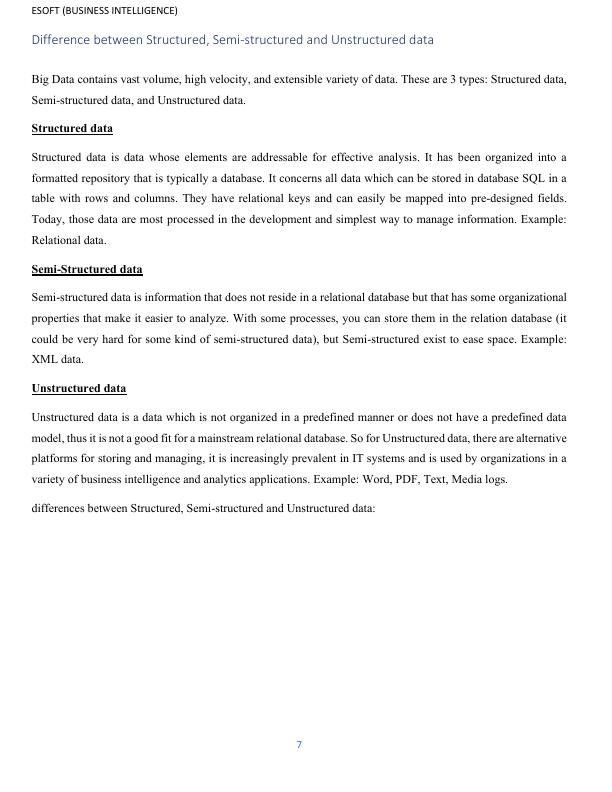
ESOFT (BUSINESS INTELLIGENCE)
8
Properties Structured data Semi-structured data Unstructured data
Technology It is based on Relational
database table
It is based on
XML/RDF(Resource
Description
Framework).
It is based on character and
binary data
Transaction
management
Matured transaction and
various concurrency
techniques
Transaction is adapted
from DBMS not
matured
No transaction management
and no concurrency
Version
management
Versioning over
tuples,row,tables
Versioning over tuples
or graph is possible
Versioned as a whole
Flexibility It is schema dependent
and less flexible
It is more flexible than
structured data but less
flexible than
unstructured data
It is more flexible and there is
absence of schema
Scalability It is very difficult to
scale DB schema
It’s scaling is simpler
than structured data
It is more scalable.
Robustness Very robust New technology, not
very spread
-
Query
performance
Structured query allow
complex joining
Queries over
anonymous nodes are
possible
Only textual queries are
possible
8
Properties Structured data Semi-structured data Unstructured data
Technology It is based on Relational
database table
It is based on
XML/RDF(Resource
Description
Framework).
It is based on character and
binary data
Transaction
management
Matured transaction and
various concurrency
techniques
Transaction is adapted
from DBMS not
matured
No transaction management
and no concurrency
Version
management
Versioning over
tuples,row,tables
Versioning over tuples
or graph is possible
Versioned as a whole
Flexibility It is schema dependent
and less flexible
It is more flexible than
structured data but less
flexible than
unstructured data
It is more flexible and there is
absence of schema
Scalability It is very difficult to
scale DB schema
It’s scaling is simpler
than structured data
It is more scalable.
Robustness Very robust New technology, not
very spread
-
Query
performance
Structured query allow
complex joining
Queries over
anonymous nodes are
possible
Only textual queries are
possible
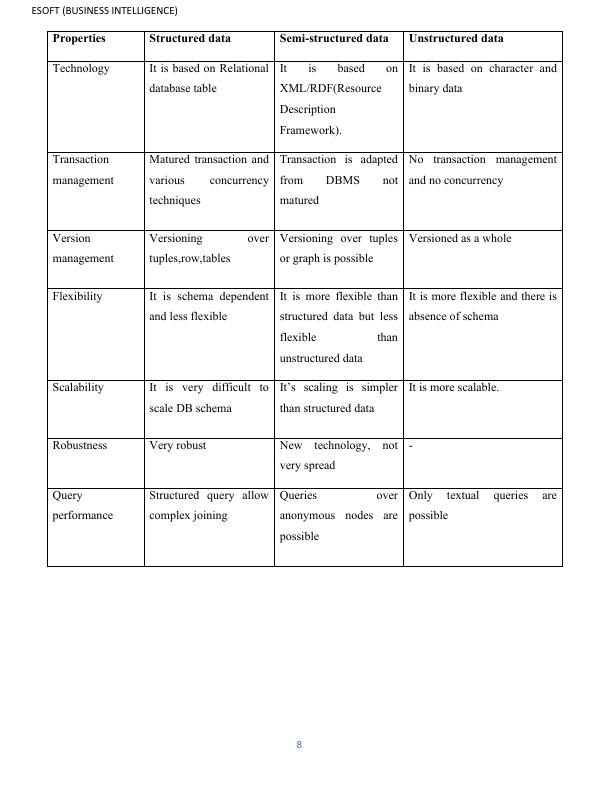
End of preview
Want to access all the pages? Upload your documents or become a member.
Related Documents
Assignment on Acknowledgement Guidance 2022lg...
|51
|14255
|37
Business Intelligence Process Assignment 2022lg...
|66
|13356
|72
Business Intelligence Toolslg...
|11
|843
|406
Business Intelligence Tools - Sisense, Qlik, Birstlg...
|6
|1127
|176
Business Intelligence Tools - PDFlg...
|11
|606
|71
Business Intelligence Reporting and Dashboard Usage for Environmental Issueslg...
|27
|4484
|39
